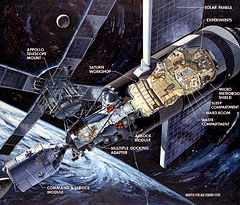 Skylab as photographed by its departing final crew (Skylab 4). | |
 Skylab program insignia | |
| Station statistics | |
|---|---|
| COSPAR ID | 1973-027A |
| SATCAT no. | 6633 |
| Call sign | Skylab |
| Crew | 3 per mission (9 total) |
| Launch | May 14, 1973 17:30:00 UTC (51 years ago) |
| Carrier rocket | Saturn V AS-513 |
| Launch pad | Kennedy LC-39A |
| Reentry | July 11, 1979 16:37:00 UTC |
| Mission status | Deorbited |
| Mass | 168,750 pounds (76,540 kg)[1] w/o Apollo CSM |
| Length | 82.4 feet (25.1 m) w/o Apollo CSM |
| Width | 55.8 feet (17.0 m) w/ one solar panel |
| Height | 36.3 feet (11.1 m) w/ telescope mount |
| Diameter | 21.67 feet (6.61 m) |
| Pressurised volume | 12,417 cubic feet (351.6 m3) |
| Atmospheric pressure | 5.0 pounds per square inch (34 kPa) Oxygen 74%, nitrogen 26%[2] |
| Perigee altitude | 269.7 miles (434.0 km) |
| Apogee altitude | 274.6 miles (441.9 km) |
| Orbital inclination | 50.0° |
| Orbital period | 93.4 minutes |
| Orbits per day | 15.4 |
| Days in orbit | 2249 days (6.6 years) |
| Days occupied | 171 days |
| No. of orbits | 34,981 |
| Distance travelled | ~890,000,000 mi (1,400,000,000 km) |
| Statistics as of Re-entry July 11, 1979 | |
| Configuration | |
 Skylab configuration as planned | |
| Part of a series on the |
| United States space program |
|---|
  |
Skylab was the United States' first space station, launched by NASA,[3] occupied for about 24 weeks between May 1973 and February 1974. It was operated by three trios of astronaut crews: Skylab 2, Skylab 3, and Skylab 4. Operations included an orbital workshop, a solar observatory, Earth observation and hundreds of experiments. Skylab's orbit eventually decayed and it disintegrated in the atmosphere on July 11, 1979, scattering debris across the Indian Ocean and Western Australia.
- ^ Belew, L. F.; Stuhlinger, E. (January 1973). "EP-107 Skylab: A Guidebook". NASA. Retrieved February 28, 2017.
 This article incorporates text from this source, which is in the public domain.
This article incorporates text from this source, which is in the public domain.
- ^ Belew (1977), p. 18
- ^ Belew (1977), p. 15